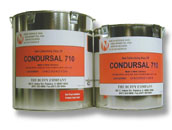 |
 |
Return to CONDURSAL 710
|
CONDURSAL 710 Instructions For Use: Before applying, stir the contents of the Condursal 710 tin thoroughly. As received, Condursal 710 is suitable for application by painting with a fine hair flat brush. Upon request, it is also available in spraying consistency (Condursal 710WE). Prior to painting, the surface of the components to be protected must be cleaned thoroughly by either a vapor degreaser or a detergent washer, so that these areas are free of oil and grease. Apply Condursal 710 as evenly as possible to a thickness of approximately 0.2 to 0.3 mm (.006" to .010"). Only one coating is necessary for effective protection. After coating, the parts should be allowed to air dry for 2 to 3 hours before carburizing. Special Notes:
Removal of Residues: After carburizing and quenching, residues of Condursal 710 can be removed by blasting. They are not soluble in water or solvents. Cleaning of brushes and other equipment: Immediately after use, Condursal 710 cans should be tightly resealed and the brushes, etc. cleaned with water. Deposits, as well as contents of can, cannot be rejuvenated if the liquid vehicle becomes dry. Therefore, if painting has to be interrupted for some period of time, brushes should be set into water to prevent the bristles from drying and getting hard. Storage: Cans of Condursal 710 should be stored in a dry cool place. Please prevent from freezing. Trouble Shooting Preface: Condursal 710 is as easily applied as an oil based paint. As with all painting, it is important to clean and degrease the surfaces to be coated thoroughly. A soft bristle brush should be used to insure a uniform coating thickness. Allow the coating to dry thoroughly before the work piece is put into the furnace. The following list is provided to address possible causes on ineffective stop-off of this paint. |
|
TROUBLE |
POSSIBLE REASONS |
HOW TO AVOID |
|
Paint runs off after applying by painting, spraying or immersion. |
1. work pieces have not been degreased satisfactorily prior to coating. |
Clean parts thoroughly by vapor degreasing or alkaline washing. |
|
2. paint has not been stirred. |
Use paint as delivered but stir thoroughly prior to use. | |
|
3. Paint has been thinned excessively. |
Use paint as delivered; add small amounts of "Special Thinner" only if thickening has occurred due to evaporation of solvent. | |
|
4. Paint has been applied in too thick a coating. |
Apply paint in one coating of uniform thickness. | |
|
| ||
|
Paint pops off after drying. |
1. Surfaces of work pieces were wet or greasy when paint was applied. |
Clean parts thoroughly by vapor degreasing or alkaline washing and make sure that they are dry prior to coating. |
|
2. Coated parts have been stored for too long a period of time at high atmospheric humidity. |
Store coated parts at a dry place and for not more than 24 hours prior to carburizing. | |
|
| ||
|
Paint runs off in the carburizing furnace. |
1. Paint has been applied in too thick a layer/ coating has not been allowed to dry thoroughly. |
Apply paint in a thin coating of uniform thickness (.008-.012") and let dry thoroughly. |
|
2. Coated parts have been stored for too long a period at high atmospheric humidity. |
Avoid storage of the coated parts at high atmospheric humidity. | |
|
3. Parts have been preheated at temperatures of more than 400 degrees F. with oxygen present. |
Limit preheating temperatures to 350 degrees F. Max. | |
|
4. Coating has come into contact with humidity in the carburizing furnace due to: | ||
|
- defective endothermic generator. |
Repair generator. | |
|
- leaking of retort cooling system. |
Repair cooling system. | |
|
- incomplete cracking of liquid carburizing media |
Start feed of liquid carburizing media after the furnace has reached 1400 degrees F. minimum. | |
|
- putting coated parts in the furnace together with other work pieces insulated with water or silicate based stop-off paint. |
Do not combine in the same batch parts coated with Condursal 710 with others coated with water or silicate based stop-off paints. | |
|
5. Coating has come into contact with oxygen in the carburizing furnace due to: | ||
|
- incorrect atmosphere regulation. |
Make sure by purging with nitrogen that furnace atmosphere, even in the beginning of the carburizing process, does not contain oxygen. | |
|
- cracking/ leaking of the retort of the furnace. |
Repair retort. | |
|
| ||
|
Residues of the paint are hard to remove after carburizing/ surface attack is noted. |
1. Coating has come into contact with humidity. |
SEE RUN-OFF PROBLEMS |
|
2. Coated parts have been cooled down after carburizing and then reheated for quenching. |
Remove residues of the parts after carburizing. | |
|
| ||
|
Protection against carbon pickup has been found to be non-uniform or non-satisfactory. |
Paint has been applied in a too thin or non-uniform layer. |
Stir paint thoroughly prior to use; apply paint in a layer of even thickness; if necessary for deep cases apply twice but keep in mind that first coating must be dry prior to application of second one. |








